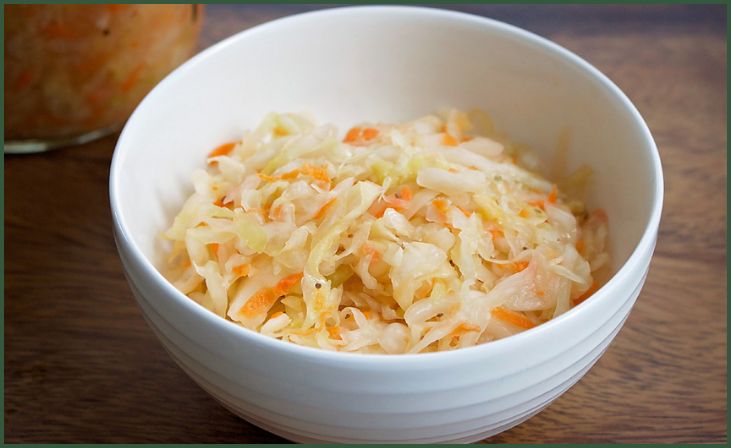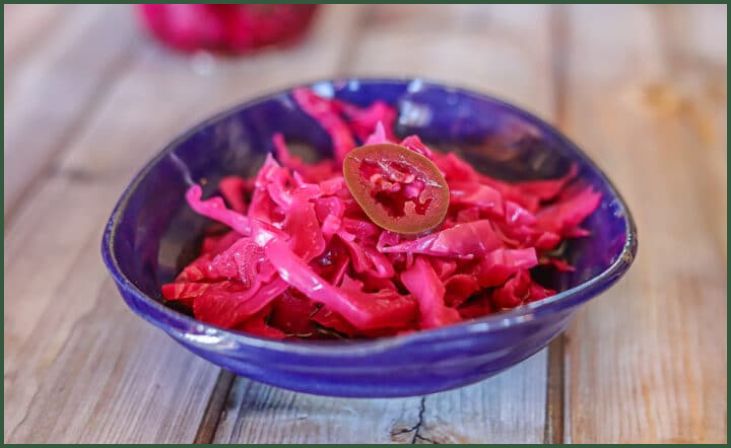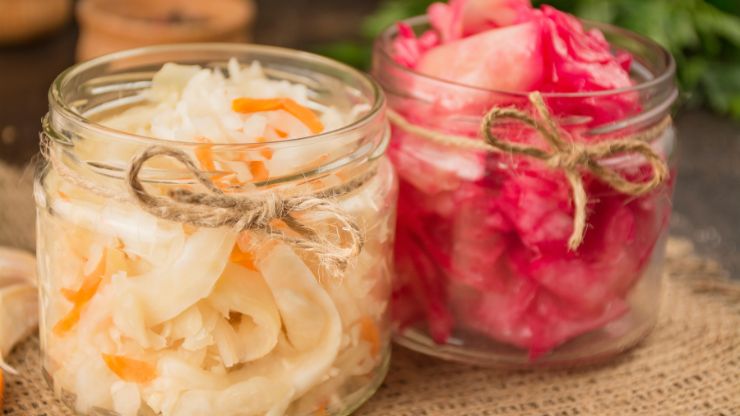Russian-style pickled cabbage, celebrated for its delightful combination of tanginess and crunchiness, has become a cherished culinary gem that has captured the hearts of food enthusiasts across the globe. In the pages of this article, we embark on a culinary journey to delve into the world of Russian-style pickled cabbage. Our mission is to unearth the top 10 recipes, each brimming with distinctive flavors and textures that are bound to tantalize your taste buds and elevate your culinary adventures to new heights.
This flavorful and versatile dish hails from the rich culinary heritage of Russia. Its allure lies in the harmonious marriage of cabbage with an array of complementary ingredients and seasonings. As we explore these 10 exceptional recipes, you’ll not only discover the artistry behind Russian-style pickled cabbage but also gain practical insights into preparing them at home.
Table of Contents
Toggle10 Best Russian-Style Pickled Cabbage
1. Traditional Russian Sauerkraut

Experience the authentic taste of Russia with our classic Russian sauerkraut recipe. This time-honored delicacy is a testament to the art of fermentation. The cabbage undergoes a transformation, developing its distinctive tangy flavor and crisp texture. You’ll learn the time-tested techniques that Russians have cherished for generations. Making this sauerkraut is like taking a culinary journey to the heart of Russia.
Also Read:- Pickled Watermelon Rind
2. Zesty Carrot and Cabbage Kraut
If you’re looking to put a delightful twist on the classic sauerkraut, look no further. Our zesty carrot and cabbage kraut recipe takes the traditional to a whole new level. The addition of zesty carrots brings a burst of flavor and color to your plate. It’s a tantalizing variation that will add a dash of vibrancy to your meals.
3. Russian-Style Kimchi Cabbage
Step into the world of fusion with our Russian-style kimchi cabbage recipe. This culinary masterpiece combines the rich flavors of Russia with the bold and spicy notes of Korean cuisine. The result is a harmonious blend of spice and tang that promises to awaken your taste buds. It’s a delightful exploration of international flavors right in your own kitchen.
4. Cabbage and Beetroot Pickle
Prepare to embrace a burst of colors and robust flavors with this traditional Russian pickle. The marriage of cabbage and beetroots creates a unique taste sensation that’s as visually appealing as it is delicious. This recipe encapsulates the essence of traditional Russian cooking with a modern twist.
5. Sweet and Sour Red Cabbage
Indulge in the perfect balance of sweet and sour with our red cabbage pickle. This recipe offers a delightful contrast of flavors that’s sure to become a household favorite. The vivid red hue and exquisite taste make it a charming addition to any table.
6. Dill and Garlic Infused Cabbage

For those who crave an explosion of flavor, our dill and garlic-infused cabbage is a must-try. Elevating the classic sauerkraut with the aromatic combination of dill and garlic, this recipe promises a taste sensation that you won’t want to miss. It’s a culinary adventure for those who appreciate bold and aromatic dishes.
Don't just scroll, subscribe!
BuzzTrail's unique web-stories are the cure for boredom you've been waiting for.
7. Russian Cabbage Rolls
Discover a whole new way to enjoy cabbage with our Russian cabbage rolls. These delectable rolls are filled with savory goodness, creating a satisfying and heartwarming meal. Each bite is a celebration of the delightful flavors that Russian cuisine has to offer.
8. Spicy Russian Cabbage Slaw
For those with a penchant for spiciness, our spicy Russian cabbage slaw is the perfect choice. It offers a fiery and flavorful experience that’s bound to delight your palate. The heat is expertly balanced with a medley of other flavors, creating a truly unique culinary treat.
9. Cabbage and Mushroom Delight
Vegetarians, rejoice! Our cabbage and mushroom pickle is a delight for your taste buds. This recipe offers a unique umami experience, bringing together the earthy goodness of mushrooms with the delightful crunch of cabbage. It’s a flavorful, vegetarian twist on the traditional pickled cabbage.
10. Cabbage and Cranberry Fusion

For those seeking a sweet and tangy twist, our cabbage and cranberry pickle is the perfect choice. This delightful fusion of flavors is suitable for any occasion. The sweet cranberries complement the tanginess of the cabbage, creating a harmonious blend that’s sure to be a crowd-pleaser.
Also Read:- Pickled Asparagus
Conclusion
In conclusion, the world of Russian-style pickled cabbage is a captivating culinary adventure that has been brought to life through these 10 Best Russian-Style Pickled Cabbage recipes. Each recipe is a gateway to a different flavor profile, a unique cultural fusion, and a delightful twist on tradition. Whether you’re an experienced chef looking to expand your repertoire or a passionate home cook seeking to add a new dimension to your meals, these recipes have something for everyone.
As you explore the pages of this article, you’re not just discovering recipes; you’re delving into the heart of Russian cuisine and experiencing the art of pickling and fermentation that has been perfected over generations. From the classic and timeless sauerkraut that offers the authentic taste of Russia to innovative variations that incorporate zesty carrots, dill, garlic, and even cranberries, this culinary journey is a testament to the versatility and creativity of Russian cooking.
So, whether you’re preparing a hearty, traditional Russian meal with sauerkraut or embarking on a flavor adventure with Russian-style kimchi or zesty cabbage slaw, these recipes promise a culinary experience like no other. They capture the spirit of Russia, where food is not just sustenance but a celebration of life.
Frequently Asked Questions
What is Russian-style pickled cabbage?
What is Russian-style pickled cabbage?
Russian-style pickled cabbage is a fermented cabbage dish, often infused with various flavors, and it’s a staple in Russian cuisine.
How long does it take to pickle cabbage?
How long does it take to pickle cabbage?
The time to pickle cabbage varies depending on the recipe. Traditional sauerkraut can take several weeks, while quick pickles can be ready in just a few days.

